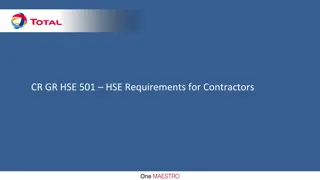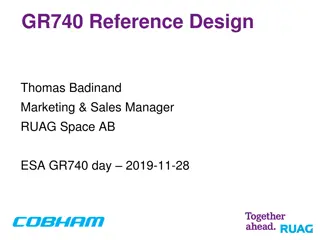HSE Requirements for Confined Space Entry - Rule CR-GR-HSE-429
This rule sets out the minimum HSE requirements to be followed for authorizing, preparing, and supervising entries into confined spaces, regardless of the planned activities. It provides detailed guidance on organization, preparation, authorization, and supervision, aiming to prevent accidents and ensure safety during confined space entries. The rule defines specific procedures, risk analysis, emergency plans, personnel training, and more to address the risks associated with confined space work. Effective implementation of these requirements is crucial for maintaining a safe working environment in confined spaces.
Download Presentation

Please find below an Image/Link to download the presentation.
The content on the website is provided AS IS for your information and personal use only. It may not be sold, licensed, or shared on other websites without obtaining consent from the author.If you encounter any issues during the download, it is possible that the publisher has removed the file from their server.
You are allowed to download the files provided on this website for personal or commercial use, subject to the condition that they are used lawfully. All files are the property of their respective owners.
The content on the website is provided AS IS for your information and personal use only. It may not be sold, licensed, or shared on other websites without obtaining consent from the author.
E N D
Presentation Transcript
HSE requirements for Confined Space Entry HSE Rule CR-GR-HSE-429 This rule defines the minimum HSE requirements to be implemented to authorise, prepare, and supervise entries into confined spaces, regardless of the type of activities planned (work, inspection, sampling, etc.).
CR-GR-HSE-429 Context: Confined Space Entry: In the Top 5 of the Company's life-threatening activities 5 fatal accidents (6 deaths) over the last 10 years (2011-2020) 11 HIPOs over the last 5 years (2016-2020) Main root cause of our fatal accidents (4/5): unintentional entries into a confined space Scope: All TotalEnergies companies and other controlled structures Defines 10 requirements, grouped into 4 themes: Organisation Preparation Authorisation Supervision Replacing the following Holding & branches documents: DIR GR SEC 004 Confined space entry CR EP HSE 045 Confined spaces CR RC HSE 105 Confined space entry CR MS HSEQ 202 14 Working in a capacity or a confined space CR G&P HSE 030 Confined space entry Date of publication in REFLEX: 31/08/2021 Effective date (+6 months): 01/03/2022
Requirements 1. Organisation Requirement 3.1.1: Confined Space Entry procedure The general process regulating Confined Space Entry is described in a documented procedure which includes the requirements of this rule as a minimum. No change (except for a possible revision of local procedures to align with this Company Rule ALL ENTITIES) 2. Preparation Requirement 3.2.1: Risk Analysis and Risk Control Plan The risk analysis for a Confined Space Entry specifically covers each stage of the operation and any special risks. A risk control plan is drawn up and specifies how the risk control measures identified in the risk analysis will be implemented. The risk analysis and the risk control plan are developed and validated jointly by representatives of the entity or affiliate, and by any contractors if involved, following a prior joint visit to the worksite. No change (except for a possibly more exhaustive approach of a Risk Management Plan ALL ENTITIES) 3
Requirements Requirement 3.2.2: Emergency Plans Confined space evacuation and rescue plans are established and regularly tested. Any operation involving Confined Space Entry requires validation of the associated emergency plans and is conditional on the availability of designated rescue teams and associated equipment. No change (apart from a possible strengthening of the partnership with external emergency services ENTITIES WITHOUT OWN RESCUE TEAMS) Requirement 3.2.3: Personnel Training and Aptitude Personnel who prepare, supervise, or perform Confined Space Entry operations are trained to fulfil their role. Personnel required to enter a confined space are physically fit. No change 4
Requirements 3. Formal authorisation for confined space entry Requirement 3.3.1: Confined Space Entry Certificate Any operation involving entries into a confined space is subject to the issue of a Confined Space Entry certificate. The certificate alone does not authorise physical entry into a confined space (which remains subject to prior and regular checks of the actual conditions of the operation), nor the start of works covered by work permits. New philosophy (rather than a new requirement) ALL ENTITIES (The instruction of such a certificate should be processed for the purpose of issuing a formal authorization to enter a confined space, whatever the need. While the current approach tends to process these files for entering a confined space on the 2ndlevel, as additional permits accompanying work permits issued for carrying out work in a confined space.) Requirement 3.3.2: Final Validation of the Certificate The final validation of the Confined Space Entry certificate is conditional on prior field checks of the: Required confined space isolations; Authorised atmospheric conditions; Effective implementation of the measures defined in the risk control plan and in the emergency plan. The confined space entry certificate is approved by a certified authority, as per the confined space entry process defined by the entity or affiliate. The certificate is declared void when the work execution method is modified or following the activation of an emergency plan. No change 5
Requirements 4. Supervision Requirement 3.4.1: Permanent Surveillance Provisions are made to ensure a permanent surveillance for any operation involving Confined Space Entry. If this task is performed in-person by a safety watcher, they never enter the confined space on their own initiative, even for rescue purposes. No change Requirement 3.4.2: Control of Unintentional Entries Once a confined space has been opened, and as long as the necessary conditions for entry are not met or the operation within the space is subsequently temporarily interrupted, access points are physically prevented (using plates, bars, chains) and explicit signs prohibiting entry without authorisation are put in place. No change (except for the possible strengthening of physical blocking and signage at any potential access point ALL ENTITIES) 6
Requirements Requirement 3.4.3: Atmospheric Conditions and Evacuation Criteria Gas tests (of oxygen level and explosiveness as a minimum, and toxicity if relevant) are carried out: Before the initial entry into a confined space; And after each significant interruption of the operation, in order to authorise the resumption of entries. Gas monitoring is implemented during any Confined Space Entry operation: Continuously by means of a collective gas detection device; Failing this, all entrants are equipped with an individual gas detector (oxygen as a minimum; other gases according to the risk analysis). In this case, gas tests are carried out at regular intervals, at a frequency defined during the risk analysis. Criteria are defined for the validation of entries and the triggering of evacuations. No change (except for the obligation to be equipped with an individual gas detector under certain conditions ALL ENTITIES) Requirement 3.4.4: Suitability of Respiratory Protective Equipment (RPE) Where Confined Space Entry requires respiratory protective equipment to be worn, this equipment is suitable for the: Nature of the atmosphere in question (inert and/or toxic gases); Ambient conditions (temperature, humidity, dust, etc.); The actual time spent in the confined space. No change 7























